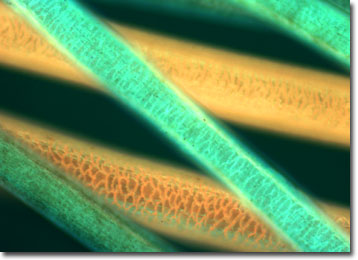Fluorescence Digital Image Gallery
Japanese Pony Belly Hair
Hair is a unique attribute of mammals and serves a variety of functions, although the primary function of hair is to preserve body heat. It also offers protection from sunlight, particularly ultraviolet light. For some species, the color and patterns of hair camouflage the animal from a potential predator or can attract a potential mate for seduction.

Japanese ponies are particularly famous for their hair. Its soft and luxurious feel to the skin has made Japanese pony hair a favorite in the world of cosmetics, used for powder brushes and other face brushes. Recently the pony hair market has expanded to include clothing, shoes, and even toys.
Considered an epidermal secretion, hair is made primarily of a protein called keratin and consists of three distinct and easily recognizable parts. The outer layer is made up of dead, transparent cells called cuticular scales. Beneath the cuticular scales is the cortex, an often-thick layer that appears featureless except that it may be pigmented. At the center of most hair types is the medulla, made up of large cells, often distinctively colored and interspersed with air pockets. The arrangement of scales, thickness and color of the cortex, and distribution and color of medulla cells vary dramatically from species to species.
A particularly dense covering, or coat, of hair is often referred to as fur. Throughout history, fur has been important to people, chiefly for warmth but also for decorative and other purposes. The pelts of fur-bearing animals are called true furs only if they consist of two elements: a dense undercoat (ground hair) and longer hairs (guard hair). Ground hair maintains the animal's body temperature and guard hair protects the underlying layer. Ponies do not possess ground hair, therefore, they do not have true fur.
The specimen presented here was imaged with a Nikon Eclipse E600 microscope operating with fluorite and/or apochromatic objectives and vertical illuminator equipped with a mercury arc lamp. Specimens were illuminated through Nikon dichromatic filter blocks containing interference filters and a dichroic mirror and imaged with standard epi-fluorescence techniques. Specific filters for the Japanese pony belly hair specimen were a UV-2E/C, B-2E/C, and a Y-2E/C. Photomicrographs were captured with an Optronics MagnaFire digital camera system coupled to the microscope with a lens-free C-mount adapter.
BACK TO THE FLUORESCENCE DIGITAL IMAGE GALLERY
